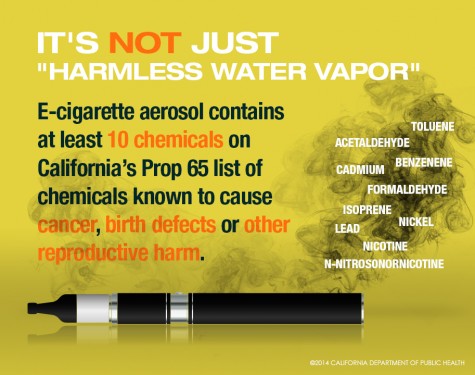The Five Most Common Myths About E-Cigarettes
A pair of typical e-cigarettes found in gas stations and from retailers.
Since the invention of electronic cigarettes, or e-cigs, there’s been no lack of murky information spread about their use. The devices, which use a vaporizer and a heating source to emit a nicotine vapor, have been embraced quickly by many Americans, often without a second thought about how safe they may be.
Even if the big names behind e-cig production don’t alarm you (Camel, Marlboro, Newport) then the difficulty posed in finding hard facts concerning e-cigs certainly should.
And, although research on e-cigs is ongoing, there is still enough data to dispel with many of the major myths floating around.
Myth #1: E-Cigarettes are better for you
E-cigarette use is often marketed as a panacea for tobacco-related deaths, helping smokers quit and keeping them plugged into their addiction all the while. The bad stuff we know is in tobacco (rat poison, mothballs, tar) just isn’t in e-cigs. Everyone wins, right?
Well, maybe not.
Preliminary research has turned up a dearth of chemicals known to cause birth defects, heart disease, and cancer.

Those keeping up with the news on the water crisis in Flint, Michigan, would be surprised to hear that lead, the very same substance that ignited a media firestorm in Flint, is also found in the vapor of some e-cigarettes.
It doesn’t stop there. Government inaction on proper e-cig regulation means that companies may put whatever they please into their products, and aren’t forced to display a warning label as is the case for traditional cigarettes. E-cig companies aren’t even obligated to release the ingredients of their products.
Researchers have been working to detect other trace compounds in e-cigs, and are likely to soon turn up additional (and perhaps more dangerous) substances within them.
Myth #2: E-cigarettes are safer to those around you
One of the most publicized e-cigarette myths is that the vapor is harmless, and is only “water vapor,” devoid of any harmful chemicals. In fact, the human body is only capable of absorbing a tiny portion of whatever substance it inhales. While this may be good news for the smoker, it’s almost certainly bad for those around them. The chemicals (including nicotine, the most addictive legal drug recognized by the CDC) are picked up by whoever is unlucky enough to be around.
And because companies are allowed to vary the amount of nicotine in their products, the FDA reports that some e-cigs have nicotine levels that can top 40 mg, more than double those of cigarettes. Nicotine, a natural stimulant, not only creates strong addiction but also leads to major heart problems in the long term, and e-cig users and those exposed secondhand are still getting a full dose.
Additionally, the lack of common regulations on e-cigs means that vaping in public, and around passive bystanders, is much more commonplace than with traditional tobacco products.
Myth #3: E-cigarettes help you quit

This advertisement captures many of the most popular themes in marketing e-cigarettes, highlighting the lessened stigma and purported safety of e-cigs.
With ads like these, it’s clear that the primary market of e-cigs are current smokers. But how much of this message is a gimmick and how much is based on reality remains to be seen.
British medical science magazine Lancet has found that e-cigs are roughly as effective as helping smokers quit as a nicotine patch, albeit still leaving them with an addiction. However, U.S. research has found differently.
But while they have potential to help current smokers quit, CDC research has also suggested that they pose a huge threat to drawing non-smokers into nicotine addiction, especially children. A 2014 CDC study of e-cig users found that nearly a quarter of e-cig users had never used a tobacco product before they began vaping.
E-cig manufacturers have also caught flak for targeting their products at young kids with flavors like cotton candy or bubblegum, a practice that was made illegal for traditional tobacco products. Only nine states (including Minnesota) have even gone so far as to prohibit sales to minors, meaning that in 41 states and the District of Columbia, an elementary schooler can buy an e-cig legally.
Myth #4: E-cigs are much cheaper
Another reason so many people find themselves drawn to e-cigs is the cost. Everyone knows that fueling a cigarette addiction is nothing if not expensive, and so many switch for the sake of cost-cutting rather than preference.
While they might not blow quite as large a hole in your pocket as regular cigarettes, e-cigs sure aren’t cheap. Information from various retailers suggests that, while they won’t set you back the $2000 on average that cigarettes will, the $1200 annual cost that vaping will cost you on average is no chump change.
And although e-cigs are cheaper right now, don’t expect this deficit to last for much longer. As the new taxes and regulations roll in, and the market grows larger, the price will only go up with time. States have shown signs that they plan to place equally heavy taxes on e-cigs as cigarettes.
Myth #5: E-cigs are less hazardous
This is often talked about by public health agencies in their coverage of e-cigarettes. Traditional cigarettes (seeing as they’re essentially burning paper and leaves) have the potential to cause hundreds of house fires each year. Some see e-cigs as a remedy to this problem, since they don’t have an actual flame involved.
But, as is often the case with e-cigs, there’s a catch. They can blow up. For no reason.
One second you’re vapin’ and feelin’ cool, and the next second you’re asking a woman in a gas station to pull off your burning pants. Worth the risk? You decide.








